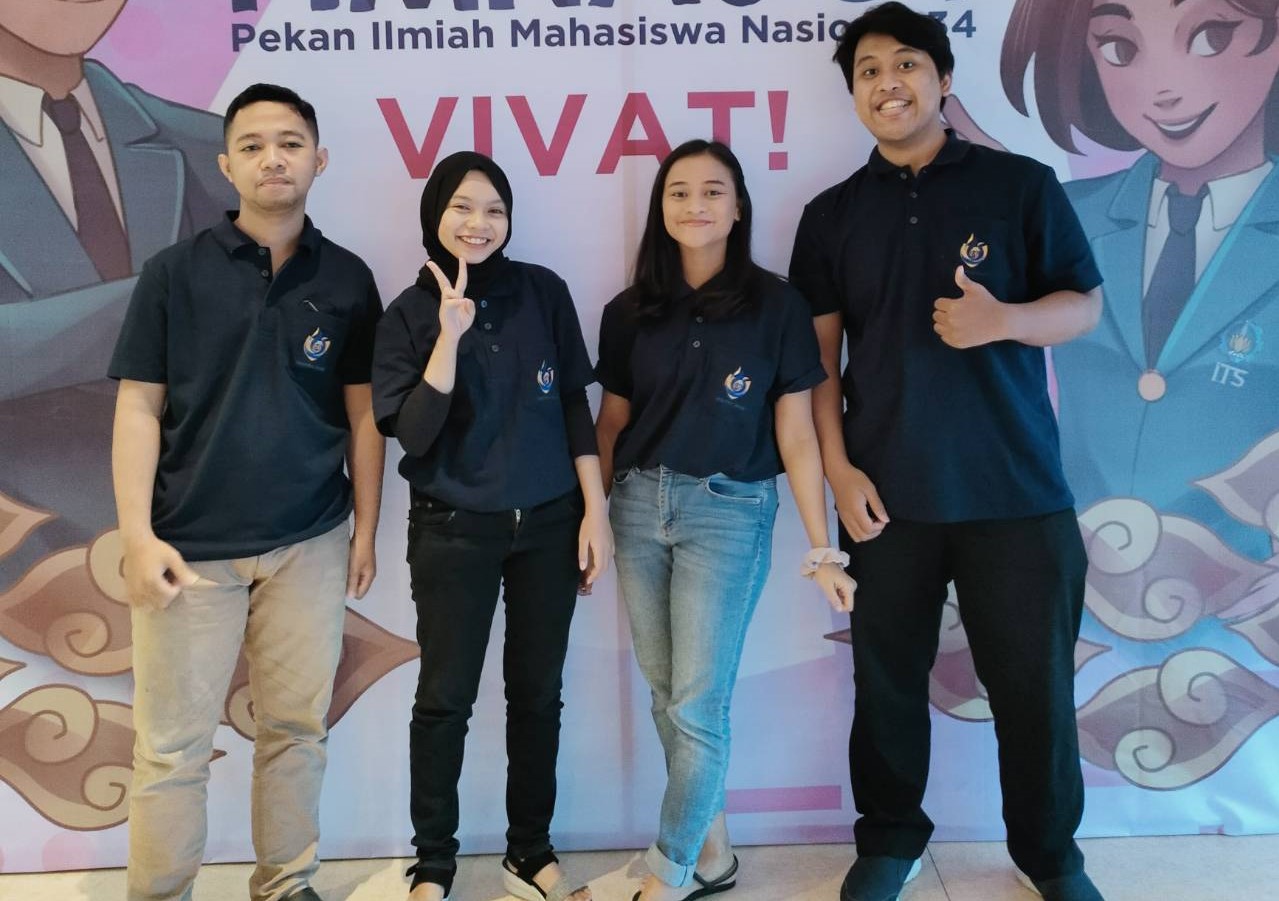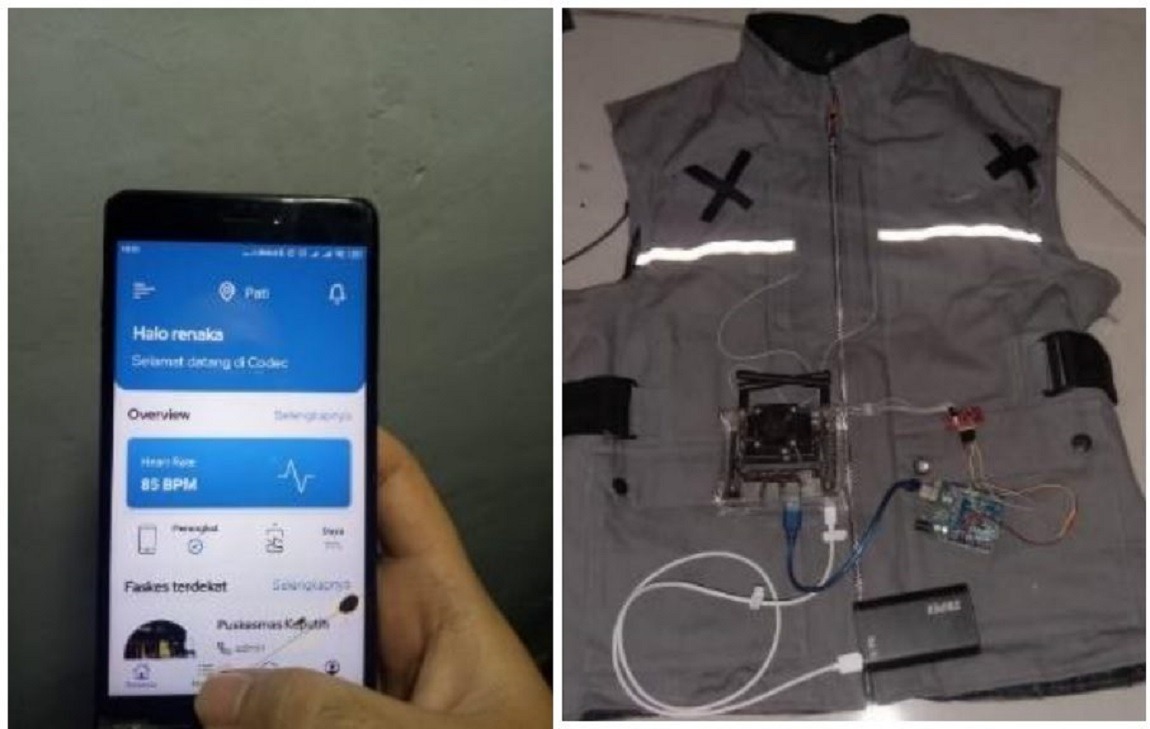ITS Students Initiate Coronary Heart Attack Detector Vest

(from left) Renaka Agusta, Izzah Awwalin, Dwisainstia Aponno, and Muhammad Cendekia Airlangga as the ITS student team who initiated the coronary heart attack detector vest
ITS Campus, ITS News – Workers who often work overtime until late at night are at risk of experiencing disturbances in the body, one of which is an increased risk of coronary heart disease. Seeing this condition, a team of students from Institut Teknologi Sepuluh Nopember (ITS) took the initiative to create a coronary heart attack detection vest as a quick response for sufferers.
The team consisted of Muhammad Cendekia Airlangga, Brilliant Rizqi Haqiqi, Renaka Agusta, Dwisainstia Aponno, and Izzah Awwalin Khoirun Nisa. These five students from the ITS Faculty of Electrical and Informatics Technology (FTEIC) gave birth to brilliant ideas in the form of Internet of Things (IoT)-based vests and deep learning connected to smartphone-based applications. The vest is projected to work to imitate the working process of the human brain.
One of the team members, Dwisainstia Aponno, said that this idea was born from their observation that heart disease is one of the leading causes of death in Indonesia. “So we see an opportunity to make a tool that can be used and is accurate in detecting a heart attack,” said the familiar student called Enzy.
Regarding the working mechanism, Enzy explained, users will be given a warning via an intelligent cell phone (cellphone) to immediately make a referral to the nearest health facility if an indication of a heart attack is detected. At the same time, the vest will also send the user’s condition and location to the nearest medical personnel so that vest can carry out that first aid in a concise and precise manner.
By taking into account the comfort aspect of the user, the vest is designed with several special considerations in mind. The primary material of the vest itself uses cotton cloth with various electronic components pinned in the pocket on the front of the vest. Then there are holes on several sides as paths for outboard electrodes and cables. “This design facilitates the layout of components flexibly that does not interfere with user activities,” explained this girl from Malang.

Coronary heart attack detector vest prototype integrated with applications on smartphones made by the ITS student team.
In the manufacturing process, the team divided the work based on the subsystem of the tool to ensure that the whole system could work well. The subsystem formed is in the form of sensor readings and user readings. “Each member assembles components according to their respective parts and integrates with courier services in sending all components,” explained Enzy.
The process then continues with creating applications on smartphones, labeling the data, and training artificial intelligence, which the team carries out online. To ensure the performance of the deep learning algorithm in the classification of heart signal input, Enzy and his team conducted tests on users with various activity conditions such as sitting, walking and running.
From the test results, the heart attack detector vest can operate with a classification accuracy of 90 percent and gives good readings when used at rest or on the move. “So that the entire system can support the rapid response by integrating the vest with the application,” said the 2018 student.
Enzy and his team have won a gold medal in the 2021 Student Creativity Program (PKM) through this solution. In the future, this heart attack detector vest can still be developed again through modification of its electronic parts so that the vest will consume less power. “In addition, the components used can be summarized again to reduce production costs,” he concluded. (ITS PR)
Reporter: Raisa Zahra Fadila
Redaktur: Astri Nawwar Kusumaningtyas
Related News
-
Supporting the Development of Material Processes, ITS Professors Utilize Biomass Waste
ITS Campus, ITS News — Innovation in material processes continues to develop to support society’s need for environmentally friendly
May 13, 2022 10:05 -
ITS Professor Ideas for Bio-Corrosion Control in Marine Structures
ITS Campus, ITS News — Coastal and offshore buildings interacting directly with seawater trigger damage, including bio-corrosion. If not
May 13, 2022 10:05 -
ITS Launches the First Marine Floating Solar Power Plant Prototype in Indonesia
ITS Campus, ITS News — Institut Teknologi Sepuluh Nopember (ITS)‘s commitment in realizing the energy transition is getting serious.
May 13, 2022 10:05 -
Targeting Champion, Bayucaraka ITS Launches Flying Robot Innovation
ITS Campus, ITS News – The Bayucaraka team at Institut Teknologi Sepuluh Nopember (ITS) has launched four new flying
May 13, 2022 10:05
